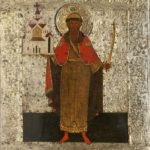
Icon with Saint Vsevolod, Grand Prince and Wonder Worker c.1575
10th October 2023
By Mike Millward, former Blackburn Museum and Art Gallery Manager and Curator
Of the 63 icons in the Blackburn collection, the most common subject is the Mother of God (Virgin and Child), and nearly half are of this subject or some aspect of the life of Christ. The rest almost all show saints and a few prophets.
Many of the saints are familiar to us – Michael, George, Nicholas and John the Baptist – but some are not as they are mainly venerated in the Orthodox Church. These include St Vsevolod.
Icons are religious images, objects of veneration used by Orthodox Christians as a conduit into the heavenly realm, or “Window into Heaven.” For more about this and other aspects of icons, see my blog posts of 5th May, 4th, 9th & 18th June 2020.
The Blackburn icon collection, one of biggest in Britain, was assembled, largely by chance, since 1970 (see blog post of 4th June 2020, Icons – What are they? By Mike Millward | Blackburn Museum). St Vsevolod is one of only two deliberately acquired, when it was purchased for the Museum to mark the Millenium in 2000. with the help of the Victoria and Albert Museum Purchase Grant Fund, the Art Fund and the Museum Friends.
This icon is a wooden panel painted in tempera in ca 1575, probably in the west of Russia. The panel is most likely to be fruit wood (I have never actually seen this particular item outside a case). A silver cover obscures almost everything but the figure of the saint and the items he is carrying. This is not unusual in a treasured icon, and there are other examples in the collection.
In tempera painting, egg yolk is used as the binding agent. It is an ancient technique commonly used in western art before the adoption of oil paint in 15th century; it continues to be the traditional medium for icons.
Saint Vsevolod is described as “Crown Prince and Wonder Worker.” He was a high born member of the ruling Rurik dynasty of the Kyivan Rus’, born in Novgorod in about 1103, the son of Mstislav the Great, Prince of Novgorod and was given the baptismal name of Gavriil (or Gabriel), by which he is also known.
The Rus’, or Varengians, were of Nordic origin, and had migrated into what is now Ukraine, Belarus and Russia during the 9th century. During the following century they became established as rulers of a federation of city states with Kyiv at the centre dominating a hierarchy of other cities ruled by subordinate relatives. The whole system is referred to as the Kyivan Rus’.
In 987 Volodymyr the Great, who ruled between 980 and1015, converted to Christianity. According to one version, he also considered Islam and Judaism, but decided against them rather than give up drinking alcohol or eating pork. He is said to have been immensely impressed by the splendour of Constantinople and the great church of Hagia Sophia. It is more likely that an alliance with the Byzantine Empire best suited his trading requirements. He married Anna, the sister of the Byzantine Emperor Basil II and converted his people en masse to Christianity. He adopted Christian principles in his own life, providing for the poor, founding schools to encourage literacy, and generally improving the lives of his subjects. He founded cities, built many churches and presided over a booming economy based on control of important trade routes across the territory.
Vsevolod was a direct descendent of Volodymyr the Great and his mother was the King of Sweden’s daughter. By his time, the Kyivan Rus’ was beginning to fragment and decline, and his father was the last great ruler, becoming Grand Prince of Kiev in 1117. At the same time, Vsevolod was made Prince of Novgorod where he ruled (with some interruption) until 1136.
He seems to have been quite successful, militarily and in other ways, until his unsuccessful campaign against Suzdal (A city east of Moscow) which led to his exile. During his principality he built numerous churches in Novgorod and was seen as a staunch defender of Christianity against the pagans.
After his exile he was invited to become Prince by the people of Pskov (in the far west on the Estonian border), where he died only a year later. The icon shows him holding a model of the Church of the Trinity in Pskov, which he re-founded before his death as a stone church to replace the wooden building founded by St Olga in the 10th century. In his other hand is a sword symbolising his military success against paganism.
After his death, a deputation arrived to take his body back to Novgorod, but his coffin would not be moved. The Novgorodians begged to have “a small piece of the Holy Dust,” and a single fingernail detached itself and was taken back to Novgorod.
He became known as “Wonder Worker” when miracles were said to have occurred through his relics, which when added to his strong history of church building and defence of Christianity, led to him swiftly becoming a saint.
His most famous wonder working was at the siege of Pskov by Polish forces in 1581, when at a crucial time in the campaign, his relics were brought to the site of battle, after which the Poles withdrew. The proximity of the date of this icon, suggests to me that its production was possibly connected with this event.